Managing and Leading Strategic Change Report: Engineering Sector, SEA
VerifiedAdded on 2022/09/14
|17
|4289
|18
Report
AI Summary
This report delves into the critical aspects of change management within the engineering sector, specifically focusing on the South East Asian region. It emphasizes the need for strategic changes in education, training, and leadership to meet the demands of the Fourth Industrial Revolution and address the infrastructural development needs of the region. The report analyzes current trends, including the shift towards urban areas and the evolving skills landscape, highlighting key areas for change such as education curriculum reforms, vocational training, and leadership development. It underscores the importance of effective communication, transparency, and a 'culture of change' driven by strong leadership to navigate challenges and ensure successful transitions within organizations and educational institutions. The study emphasizes the role of managers and leaders in driving these changes, offering insights into how they can foster a supportive environment and guide their teams through periods of instability, thereby contributing to sustainable economic growth and social equity.
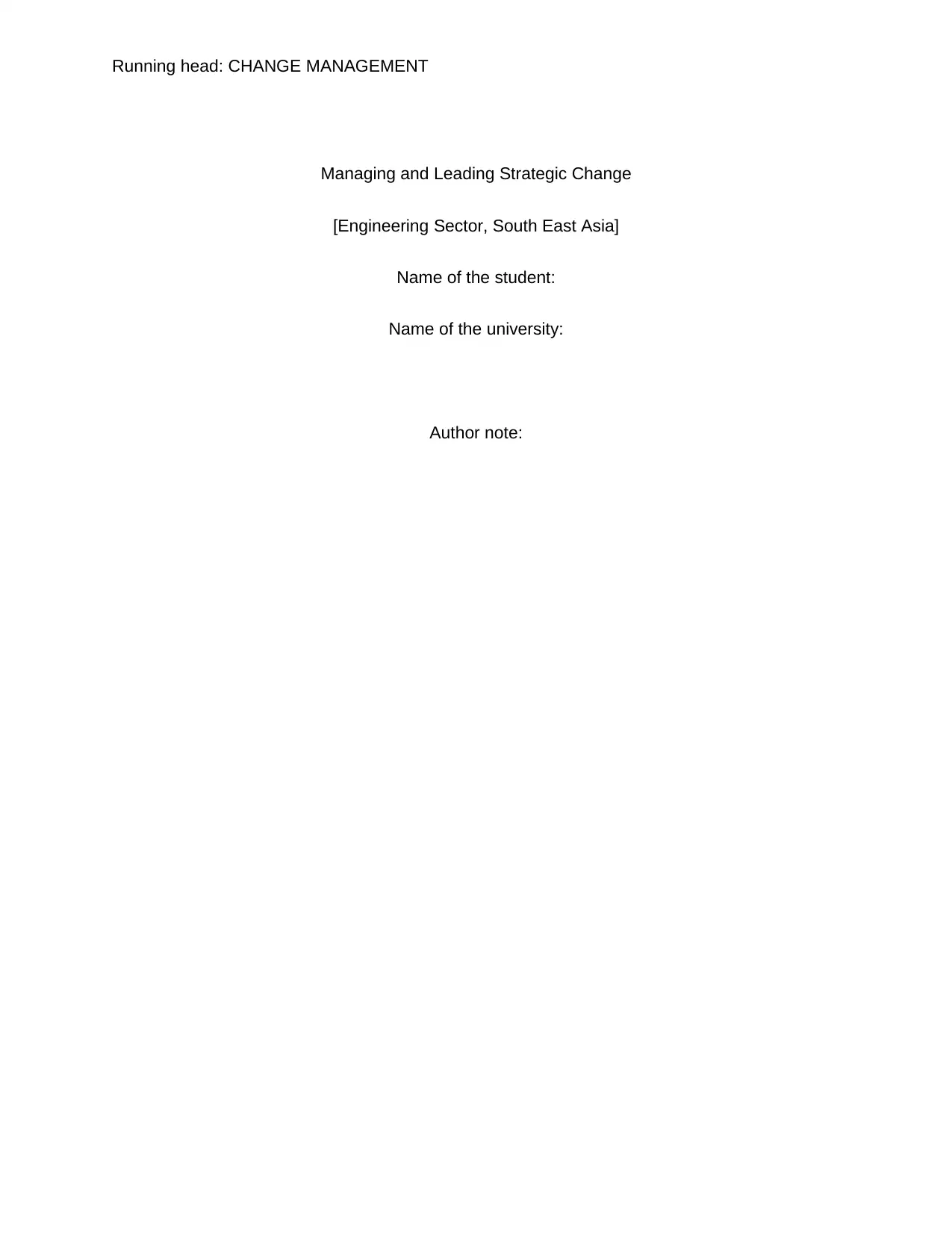
Running head: CHANGE MANAGEMENT
Managing and Leading Strategic Change
[Engineering Sector, South East Asia]
Name of the student:
Name of the university:
Author note:
Managing and Leading Strategic Change
[Engineering Sector, South East Asia]
Name of the student:
Name of the university:
Author note:
Paraphrase This Document
Need a fresh take? Get an instant paraphrase of this document with our AI Paraphraser

1CHANGE MANAGEMENT
Executive summary
Managing and leading strategic change is never an easy process to conduct. It always up to a
few barriers that interrupt the progress. This study also serves a similar purpose. The main
context of this study is to show an urgency to the change in key areas related to the education
and the business places in the South East Asian nations. The study finds that there are
possibilities to drive changes at the education and at the business level provided if certain
needs of the change are met. These are advancing processes related to education, training and
leadership. An advancement along these areas is a possibility provided if the SEA region has a
supportive regulatory structure.
Executive summary
Managing and leading strategic change is never an easy process to conduct. It always up to a
few barriers that interrupt the progress. This study also serves a similar purpose. The main
context of this study is to show an urgency to the change in key areas related to the education
and the business places in the South East Asian nations. The study finds that there are
possibilities to drive changes at the education and at the business level provided if certain
needs of the change are met. These are advancing processes related to education, training and
leadership. An advancement along these areas is a possibility provided if the SEA region has a
supportive regulatory structure.
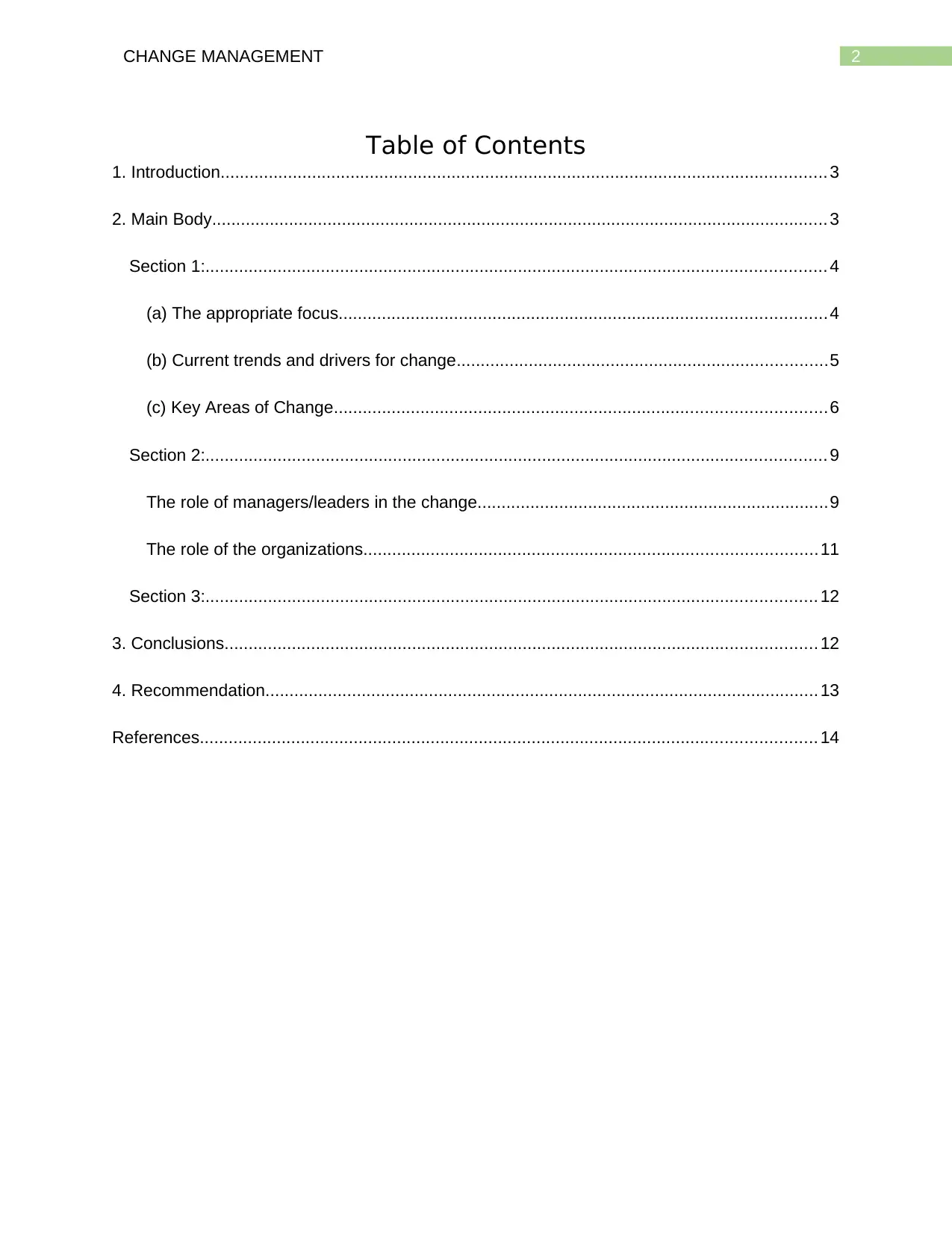
2CHANGE MANAGEMENT
Table of Contents
1. Introduction.............................................................................................................................. 3
2. Main Body................................................................................................................................ 3
Section 1:................................................................................................................................. 4
(a) The appropriate focus.....................................................................................................4
(b) Current trends and drivers for change.............................................................................5
(c) Key Areas of Change......................................................................................................6
Section 2:................................................................................................................................. 9
The role of managers/leaders in the change.........................................................................9
The role of the organizations..............................................................................................11
Section 3:............................................................................................................................... 12
3. Conclusions........................................................................................................................... 12
4. Recommendation................................................................................................................... 13
References................................................................................................................................ 14
Table of Contents
1. Introduction.............................................................................................................................. 3
2. Main Body................................................................................................................................ 3
Section 1:................................................................................................................................. 4
(a) The appropriate focus.....................................................................................................4
(b) Current trends and drivers for change.............................................................................5
(c) Key Areas of Change......................................................................................................6
Section 2:................................................................................................................................. 9
The role of managers/leaders in the change.........................................................................9
The role of the organizations..............................................................................................11
Section 3:............................................................................................................................... 12
3. Conclusions........................................................................................................................... 12
4. Recommendation................................................................................................................... 13
References................................................................................................................................ 14
⊘ This is a preview!⊘
Do you want full access?
Subscribe today to unlock all pages.

Trusted by 1+ million students worldwide
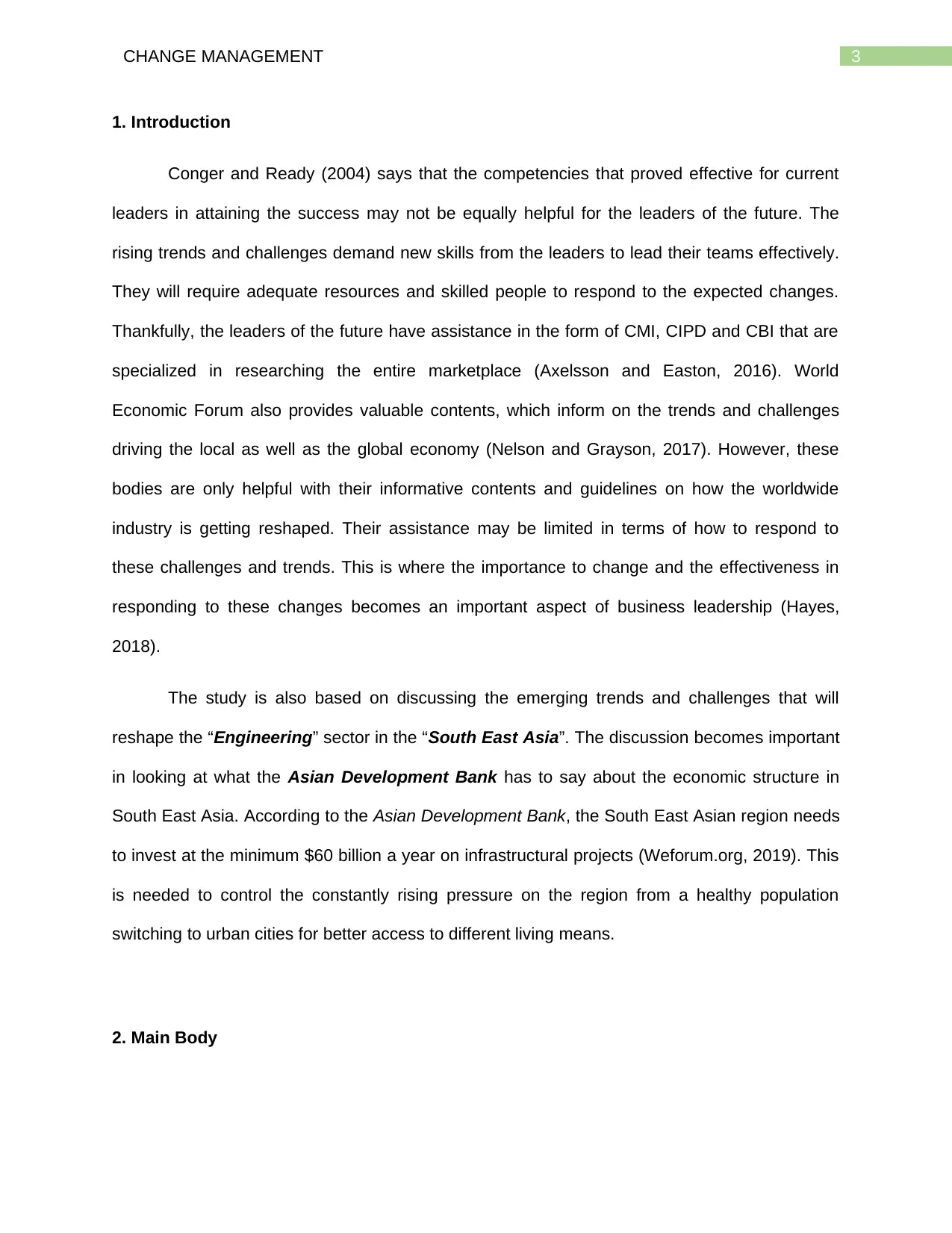
3CHANGE MANAGEMENT
1. Introduction
Conger and Ready (2004) says that the competencies that proved effective for current
leaders in attaining the success may not be equally helpful for the leaders of the future. The
rising trends and challenges demand new skills from the leaders to lead their teams effectively.
They will require adequate resources and skilled people to respond to the expected changes.
Thankfully, the leaders of the future have assistance in the form of CMI, CIPD and CBI that are
specialized in researching the entire marketplace (Axelsson and Easton, 2016). World
Economic Forum also provides valuable contents, which inform on the trends and challenges
driving the local as well as the global economy (Nelson and Grayson, 2017). However, these
bodies are only helpful with their informative contents and guidelines on how the worldwide
industry is getting reshaped. Their assistance may be limited in terms of how to respond to
these challenges and trends. This is where the importance to change and the effectiveness in
responding to these changes becomes an important aspect of business leadership (Hayes,
2018).
The study is also based on discussing the emerging trends and challenges that will
reshape the “Engineering” sector in the “South East Asia”. The discussion becomes important
in looking at what the Asian Development Bank has to say about the economic structure in
South East Asia. According to the Asian Development Bank, the South East Asian region needs
to invest at the minimum $60 billion a year on infrastructural projects (Weforum.org, 2019). This
is needed to control the constantly rising pressure on the region from a healthy population
switching to urban cities for better access to different living means.
2. Main Body
1. Introduction
Conger and Ready (2004) says that the competencies that proved effective for current
leaders in attaining the success may not be equally helpful for the leaders of the future. The
rising trends and challenges demand new skills from the leaders to lead their teams effectively.
They will require adequate resources and skilled people to respond to the expected changes.
Thankfully, the leaders of the future have assistance in the form of CMI, CIPD and CBI that are
specialized in researching the entire marketplace (Axelsson and Easton, 2016). World
Economic Forum also provides valuable contents, which inform on the trends and challenges
driving the local as well as the global economy (Nelson and Grayson, 2017). However, these
bodies are only helpful with their informative contents and guidelines on how the worldwide
industry is getting reshaped. Their assistance may be limited in terms of how to respond to
these challenges and trends. This is where the importance to change and the effectiveness in
responding to these changes becomes an important aspect of business leadership (Hayes,
2018).
The study is also based on discussing the emerging trends and challenges that will
reshape the “Engineering” sector in the “South East Asia”. The discussion becomes important
in looking at what the Asian Development Bank has to say about the economic structure in
South East Asia. According to the Asian Development Bank, the South East Asian region needs
to invest at the minimum $60 billion a year on infrastructural projects (Weforum.org, 2019). This
is needed to control the constantly rising pressure on the region from a healthy population
switching to urban cities for better access to different living means.
2. Main Body
Paraphrase This Document
Need a fresh take? Get an instant paraphrase of this document with our AI Paraphraser
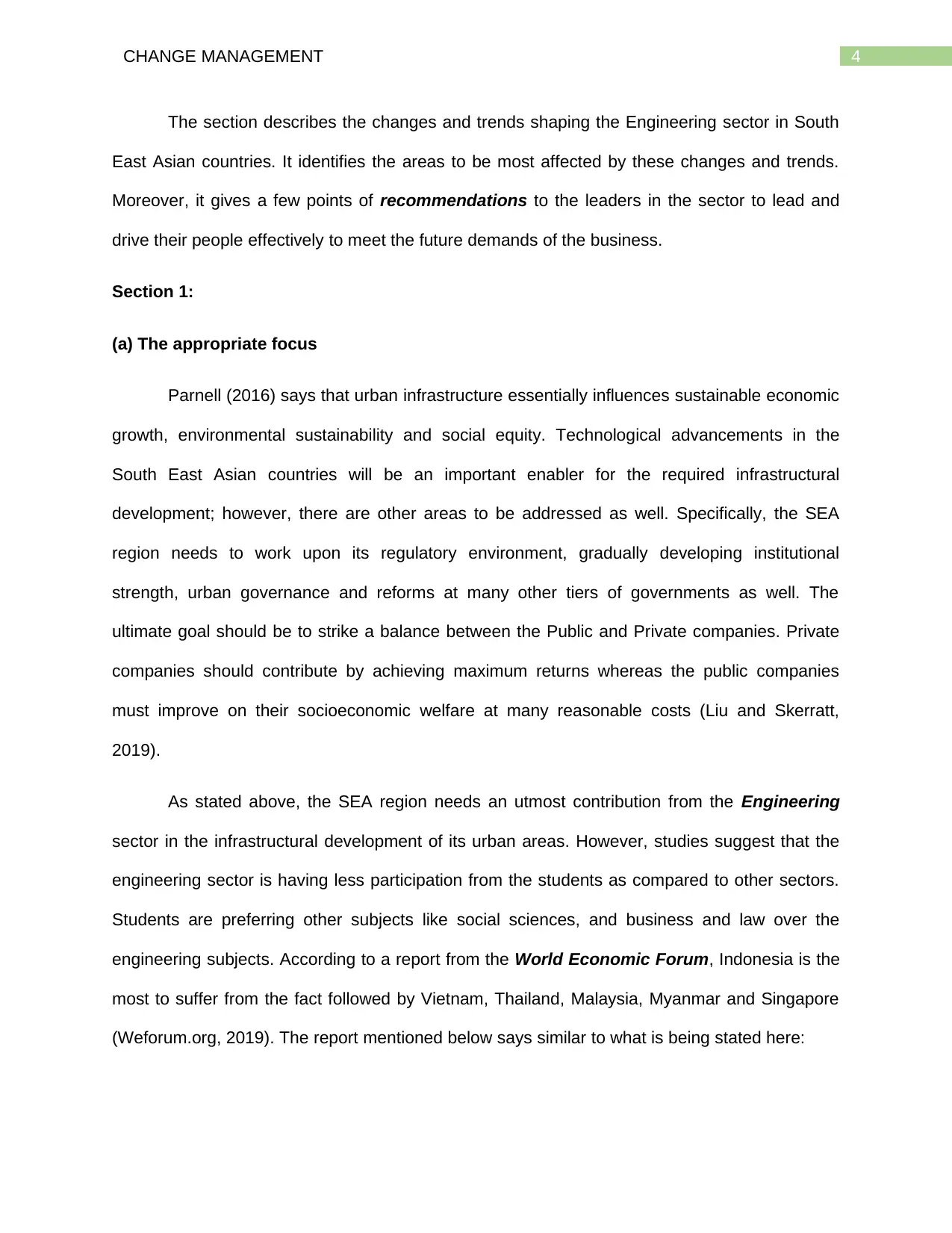
4CHANGE MANAGEMENT
The section describes the changes and trends shaping the Engineering sector in South
East Asian countries. It identifies the areas to be most affected by these changes and trends.
Moreover, it gives a few points of recommendations to the leaders in the sector to lead and
drive their people effectively to meet the future demands of the business.
Section 1:
(a) The appropriate focus
Parnell (2016) says that urban infrastructure essentially influences sustainable economic
growth, environmental sustainability and social equity. Technological advancements in the
South East Asian countries will be an important enabler for the required infrastructural
development; however, there are other areas to be addressed as well. Specifically, the SEA
region needs to work upon its regulatory environment, gradually developing institutional
strength, urban governance and reforms at many other tiers of governments as well. The
ultimate goal should be to strike a balance between the Public and Private companies. Private
companies should contribute by achieving maximum returns whereas the public companies
must improve on their socioeconomic welfare at many reasonable costs (Liu and Skerratt,
2019).
As stated above, the SEA region needs an utmost contribution from the Engineering
sector in the infrastructural development of its urban areas. However, studies suggest that the
engineering sector is having less participation from the students as compared to other sectors.
Students are preferring other subjects like social sciences, and business and law over the
engineering subjects. According to a report from the World Economic Forum, Indonesia is the
most to suffer from the fact followed by Vietnam, Thailand, Malaysia, Myanmar and Singapore
(Weforum.org, 2019). The report mentioned below says similar to what is being stated here:
The section describes the changes and trends shaping the Engineering sector in South
East Asian countries. It identifies the areas to be most affected by these changes and trends.
Moreover, it gives a few points of recommendations to the leaders in the sector to lead and
drive their people effectively to meet the future demands of the business.
Section 1:
(a) The appropriate focus
Parnell (2016) says that urban infrastructure essentially influences sustainable economic
growth, environmental sustainability and social equity. Technological advancements in the
South East Asian countries will be an important enabler for the required infrastructural
development; however, there are other areas to be addressed as well. Specifically, the SEA
region needs to work upon its regulatory environment, gradually developing institutional
strength, urban governance and reforms at many other tiers of governments as well. The
ultimate goal should be to strike a balance between the Public and Private companies. Private
companies should contribute by achieving maximum returns whereas the public companies
must improve on their socioeconomic welfare at many reasonable costs (Liu and Skerratt,
2019).
As stated above, the SEA region needs an utmost contribution from the Engineering
sector in the infrastructural development of its urban areas. However, studies suggest that the
engineering sector is having less participation from the students as compared to other sectors.
Students are preferring other subjects like social sciences, and business and law over the
engineering subjects. According to a report from the World Economic Forum, Indonesia is the
most to suffer from the fact followed by Vietnam, Thailand, Malaysia, Myanmar and Singapore
(Weforum.org, 2019). The report mentioned below says similar to what is being stated here:

5CHANGE MANAGEMENT
Figure 1: Enrollment across the Sectors
(Source: Weforum.org, 2019)
(b) Current trends and drivers for change
The South East Asian countries have performed exceptionally well so far in regards to
low-skilled and cheap labor (Dayley, 2018). However, the world is now moving faster towards
the Fourth Industrial Revolution. The North American and the European countries, in particular,
have been very progressive towards the revolution (Schwab, 2017). The question arises here
whether the South East Asian countries have the appropriate resources and skills to be
progressive as well towards this revolution. Indeed, it is very difficult to say anything about it at
this point. To take the significant advantage of the opportunities coming to the Engineering
sector countries will require to work upon improving the work skills of their people. Several
South East Asian countries have performed even better than many global countries in terms of
developing skills in people. Notably, Singapore, Malaysia, Indonesia and the Philippines have
skilled people in good numbers. However, few other countries like Cambodia, Thailand and
Figure 1: Enrollment across the Sectors
(Source: Weforum.org, 2019)
(b) Current trends and drivers for change
The South East Asian countries have performed exceptionally well so far in regards to
low-skilled and cheap labor (Dayley, 2018). However, the world is now moving faster towards
the Fourth Industrial Revolution. The North American and the European countries, in particular,
have been very progressive towards the revolution (Schwab, 2017). The question arises here
whether the South East Asian countries have the appropriate resources and skills to be
progressive as well towards this revolution. Indeed, it is very difficult to say anything about it at
this point. To take the significant advantage of the opportunities coming to the Engineering
sector countries will require to work upon improving the work skills of their people. Several
South East Asian countries have performed even better than many global countries in terms of
developing skills in people. Notably, Singapore, Malaysia, Indonesia and the Philippines have
skilled people in good numbers. However, few other countries like Cambodia, Thailand and
⊘ This is a preview!⊘
Do you want full access?
Subscribe today to unlock all pages.

Trusted by 1+ million students worldwide
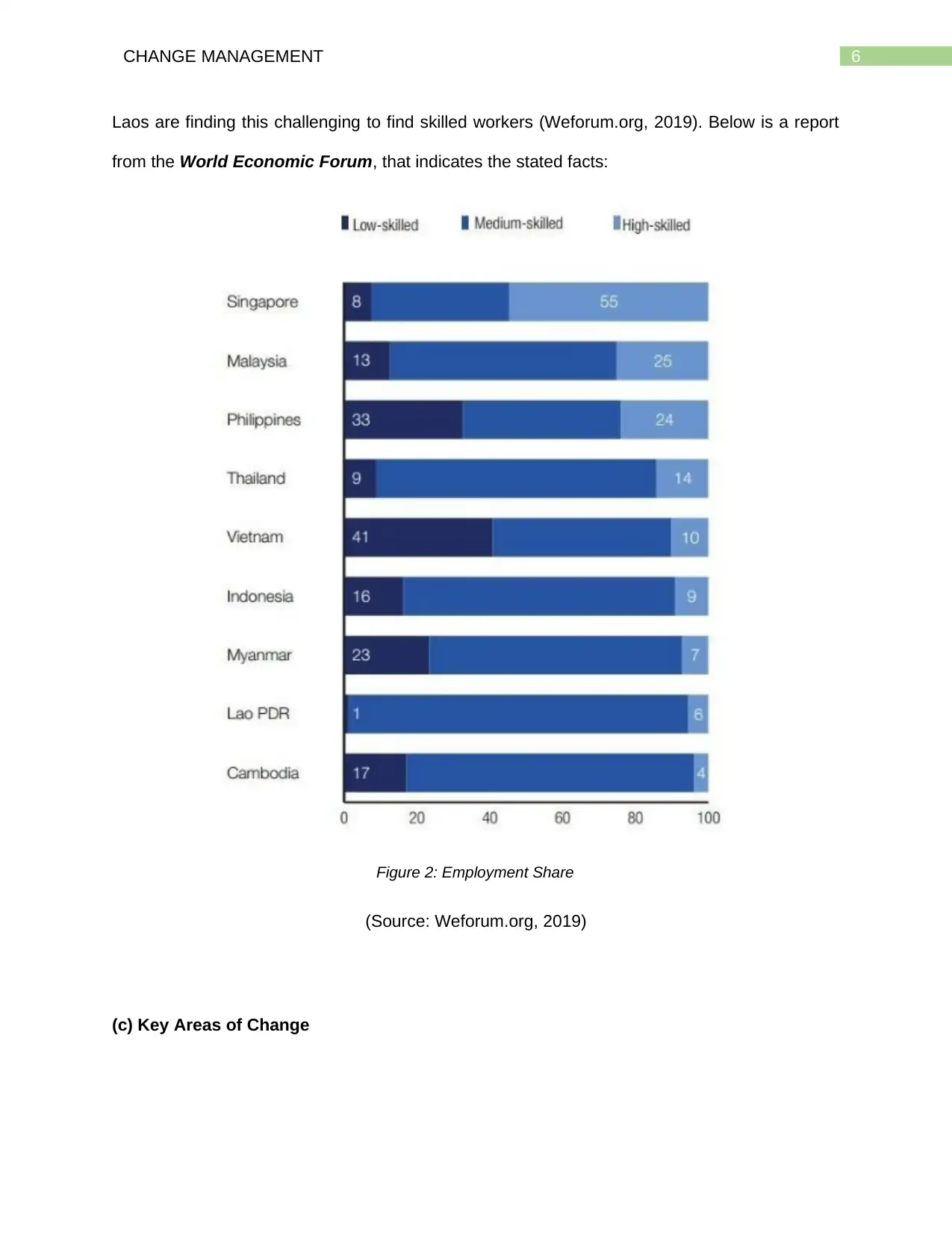
6CHANGE MANAGEMENT
Laos are finding this challenging to find skilled workers (Weforum.org, 2019). Below is a report
from the World Economic Forum, that indicates the stated facts:
Figure 2: Employment Share
(Source: Weforum.org, 2019)
(c) Key Areas of Change
Laos are finding this challenging to find skilled workers (Weforum.org, 2019). Below is a report
from the World Economic Forum, that indicates the stated facts:
Figure 2: Employment Share
(Source: Weforum.org, 2019)
(c) Key Areas of Change
Paraphrase This Document
Need a fresh take? Get an instant paraphrase of this document with our AI Paraphraser
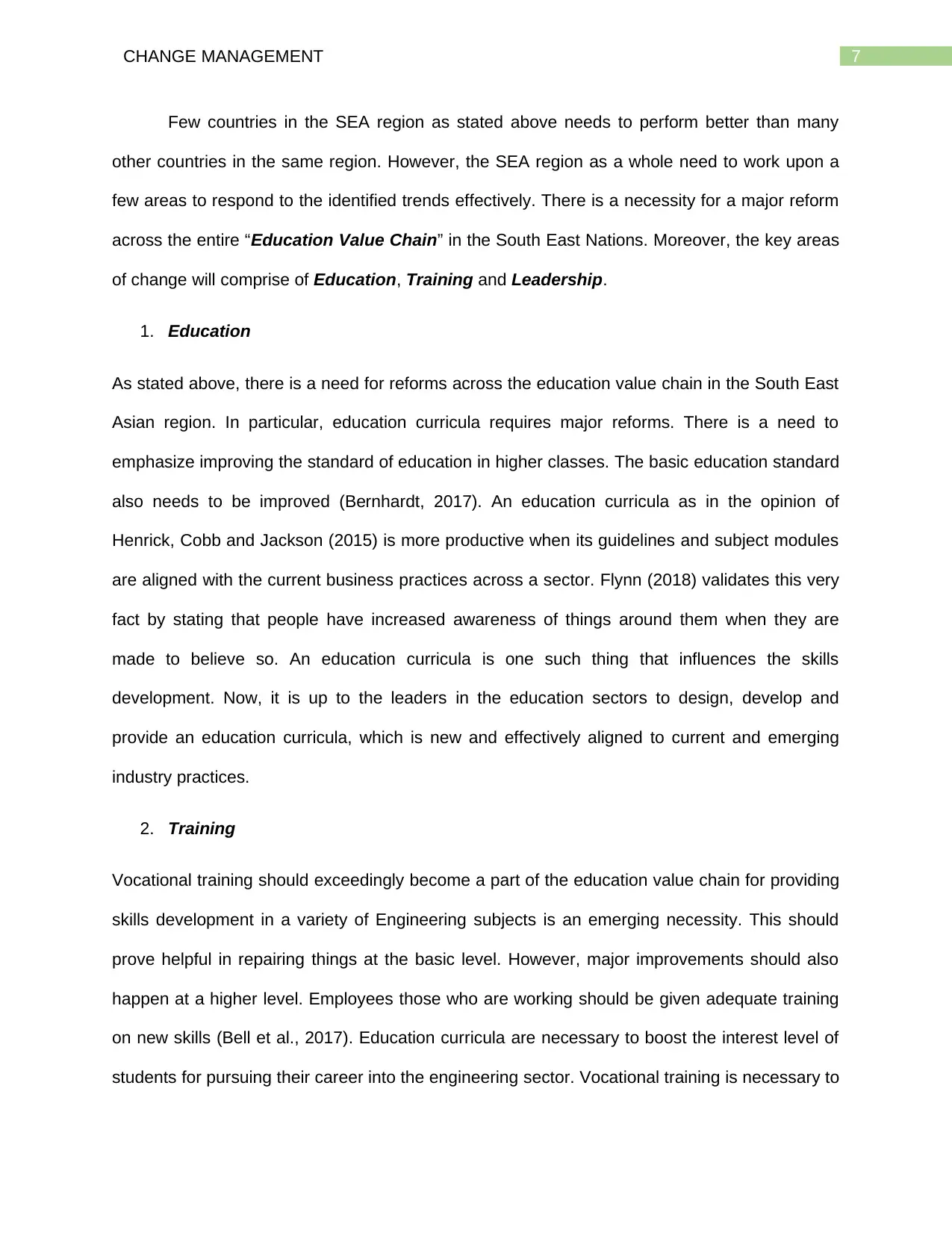
7CHANGE MANAGEMENT
Few countries in the SEA region as stated above needs to perform better than many
other countries in the same region. However, the SEA region as a whole need to work upon a
few areas to respond to the identified trends effectively. There is a necessity for a major reform
across the entire “Education Value Chain” in the South East Nations. Moreover, the key areas
of change will comprise of Education, Training and Leadership.
1. Education
As stated above, there is a need for reforms across the education value chain in the South East
Asian region. In particular, education curricula requires major reforms. There is a need to
emphasize improving the standard of education in higher classes. The basic education standard
also needs to be improved (Bernhardt, 2017). An education curricula as in the opinion of
Henrick, Cobb and Jackson (2015) is more productive when its guidelines and subject modules
are aligned with the current business practices across a sector. Flynn (2018) validates this very
fact by stating that people have increased awareness of things around them when they are
made to believe so. An education curricula is one such thing that influences the skills
development. Now, it is up to the leaders in the education sectors to design, develop and
provide an education curricula, which is new and effectively aligned to current and emerging
industry practices.
2. Training
Vocational training should exceedingly become a part of the education value chain for providing
skills development in a variety of Engineering subjects is an emerging necessity. This should
prove helpful in repairing things at the basic level. However, major improvements should also
happen at a higher level. Employees those who are working should be given adequate training
on new skills (Bell et al., 2017). Education curricula are necessary to boost the interest level of
students for pursuing their career into the engineering sector. Vocational training is necessary to
Few countries in the SEA region as stated above needs to perform better than many
other countries in the same region. However, the SEA region as a whole need to work upon a
few areas to respond to the identified trends effectively. There is a necessity for a major reform
across the entire “Education Value Chain” in the South East Nations. Moreover, the key areas
of change will comprise of Education, Training and Leadership.
1. Education
As stated above, there is a need for reforms across the education value chain in the South East
Asian region. In particular, education curricula requires major reforms. There is a need to
emphasize improving the standard of education in higher classes. The basic education standard
also needs to be improved (Bernhardt, 2017). An education curricula as in the opinion of
Henrick, Cobb and Jackson (2015) is more productive when its guidelines and subject modules
are aligned with the current business practices across a sector. Flynn (2018) validates this very
fact by stating that people have increased awareness of things around them when they are
made to believe so. An education curricula is one such thing that influences the skills
development. Now, it is up to the leaders in the education sectors to design, develop and
provide an education curricula, which is new and effectively aligned to current and emerging
industry practices.
2. Training
Vocational training should exceedingly become a part of the education value chain for providing
skills development in a variety of Engineering subjects is an emerging necessity. This should
prove helpful in repairing things at the basic level. However, major improvements should also
happen at a higher level. Employees those who are working should be given adequate training
on new skills (Bell et al., 2017). Education curricula are necessary to boost the interest level of
students for pursuing their career into the engineering sector. Vocational training is necessary to
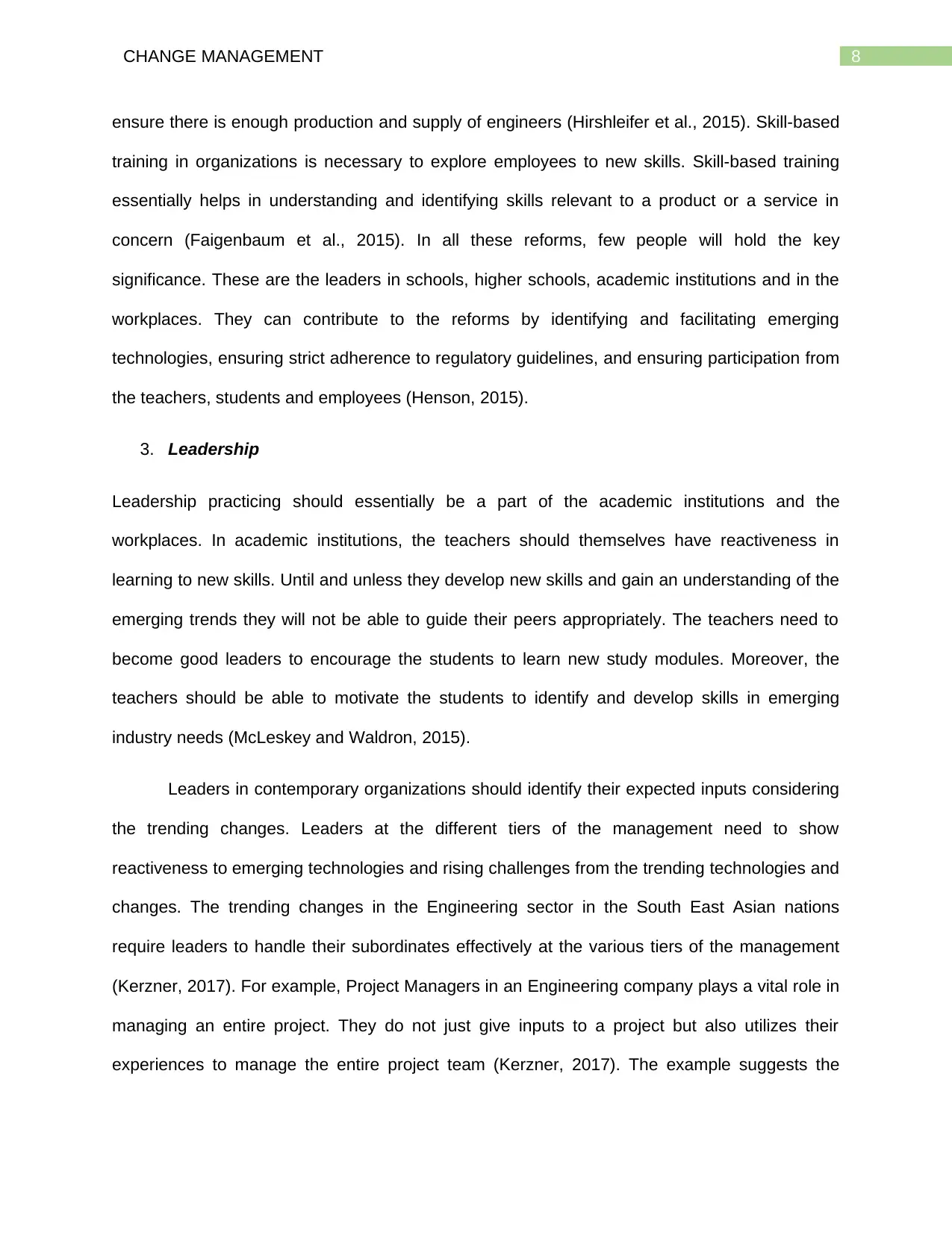
8CHANGE MANAGEMENT
ensure there is enough production and supply of engineers (Hirshleifer et al., 2015). Skill-based
training in organizations is necessary to explore employees to new skills. Skill-based training
essentially helps in understanding and identifying skills relevant to a product or a service in
concern (Faigenbaum et al., 2015). In all these reforms, few people will hold the key
significance. These are the leaders in schools, higher schools, academic institutions and in the
workplaces. They can contribute to the reforms by identifying and facilitating emerging
technologies, ensuring strict adherence to regulatory guidelines, and ensuring participation from
the teachers, students and employees (Henson, 2015).
3. Leadership
Leadership practicing should essentially be a part of the academic institutions and the
workplaces. In academic institutions, the teachers should themselves have reactiveness in
learning to new skills. Until and unless they develop new skills and gain an understanding of the
emerging trends they will not be able to guide their peers appropriately. The teachers need to
become good leaders to encourage the students to learn new study modules. Moreover, the
teachers should be able to motivate the students to identify and develop skills in emerging
industry needs (McLeskey and Waldron, 2015).
Leaders in contemporary organizations should identify their expected inputs considering
the trending changes. Leaders at the different tiers of the management need to show
reactiveness to emerging technologies and rising challenges from the trending technologies and
changes. The trending changes in the Engineering sector in the South East Asian nations
require leaders to handle their subordinates effectively at the various tiers of the management
(Kerzner, 2017). For example, Project Managers in an Engineering company plays a vital role in
managing an entire project. They do not just give inputs to a project but also utilizes their
experiences to manage the entire project team (Kerzner, 2017). The example suggests the
ensure there is enough production and supply of engineers (Hirshleifer et al., 2015). Skill-based
training in organizations is necessary to explore employees to new skills. Skill-based training
essentially helps in understanding and identifying skills relevant to a product or a service in
concern (Faigenbaum et al., 2015). In all these reforms, few people will hold the key
significance. These are the leaders in schools, higher schools, academic institutions and in the
workplaces. They can contribute to the reforms by identifying and facilitating emerging
technologies, ensuring strict adherence to regulatory guidelines, and ensuring participation from
the teachers, students and employees (Henson, 2015).
3. Leadership
Leadership practicing should essentially be a part of the academic institutions and the
workplaces. In academic institutions, the teachers should themselves have reactiveness in
learning to new skills. Until and unless they develop new skills and gain an understanding of the
emerging trends they will not be able to guide their peers appropriately. The teachers need to
become good leaders to encourage the students to learn new study modules. Moreover, the
teachers should be able to motivate the students to identify and develop skills in emerging
industry needs (McLeskey and Waldron, 2015).
Leaders in contemporary organizations should identify their expected inputs considering
the trending changes. Leaders at the different tiers of the management need to show
reactiveness to emerging technologies and rising challenges from the trending technologies and
changes. The trending changes in the Engineering sector in the South East Asian nations
require leaders to handle their subordinates effectively at the various tiers of the management
(Kerzner, 2017). For example, Project Managers in an Engineering company plays a vital role in
managing an entire project. They do not just give inputs to a project but also utilizes their
experiences to manage the entire project team (Kerzner, 2017). The example suggests the
⊘ This is a preview!⊘
Do you want full access?
Subscribe today to unlock all pages.

Trusted by 1+ million students worldwide

9CHANGE MANAGEMENT
skills development for both the project managers and the project members. A reactive approach
is needed to show urgency to trending changes in the Engineering sector in SEA region.
In the opinion of Doppelt (2017), changes irrespective of the sizes require the leaders to
respond to these changes effectively. It is how they are able to cope with a change and direct
the overall process with short-term successes is crucial to the success of the organizations.
Cameron and Green (2015) say that change brings instability. It is the effective leaders who
provide consistency to the entire change process. Moreover, they help their subordinates align
with the vision of the change during the entire transitional times. Leadership skills in managers
help them identify the strengths and weaknesses of their subordinates. Moreover, these leaders
provide a strong base or give foundation to professional development programs.
Section 2:
The role of managers/leaders in the change
External changes, which come from circumstances beyond the control of a leader make
things difficult for the leader to manage it. The leader can never but with planned transitions can
help its subordinates to adapt to the changes. The challenge the lies in a transition process
makes the leadership role even more important for the managers. Three areas of a change
have been identified for this study.
Communication is an important leadership skill for an entire change process (Randall,
2004). Whether the change is related to basic education and the vocational level or it is related
to contemporary organizations, effective communication between the leaders and its
subordinates will be important. Effective communication allows monitoring how the subordinates
are responding to the change. It helps to realize whether there is any challenge being faced by
any of the subordinates. By knowing all these things the leaders could offer valuable
skills development for both the project managers and the project members. A reactive approach
is needed to show urgency to trending changes in the Engineering sector in SEA region.
In the opinion of Doppelt (2017), changes irrespective of the sizes require the leaders to
respond to these changes effectively. It is how they are able to cope with a change and direct
the overall process with short-term successes is crucial to the success of the organizations.
Cameron and Green (2015) say that change brings instability. It is the effective leaders who
provide consistency to the entire change process. Moreover, they help their subordinates align
with the vision of the change during the entire transitional times. Leadership skills in managers
help them identify the strengths and weaknesses of their subordinates. Moreover, these leaders
provide a strong base or give foundation to professional development programs.
Section 2:
The role of managers/leaders in the change
External changes, which come from circumstances beyond the control of a leader make
things difficult for the leader to manage it. The leader can never but with planned transitions can
help its subordinates to adapt to the changes. The challenge the lies in a transition process
makes the leadership role even more important for the managers. Three areas of a change
have been identified for this study.
Communication is an important leadership skill for an entire change process (Randall,
2004). Whether the change is related to basic education and the vocational level or it is related
to contemporary organizations, effective communication between the leaders and its
subordinates will be important. Effective communication allows monitoring how the subordinates
are responding to the change. It helps to realize whether there is any challenge being faced by
any of the subordinates. By knowing all these things the leaders could offer valuable
Paraphrase This Document
Need a fresh take? Get an instant paraphrase of this document with our AI Paraphraser
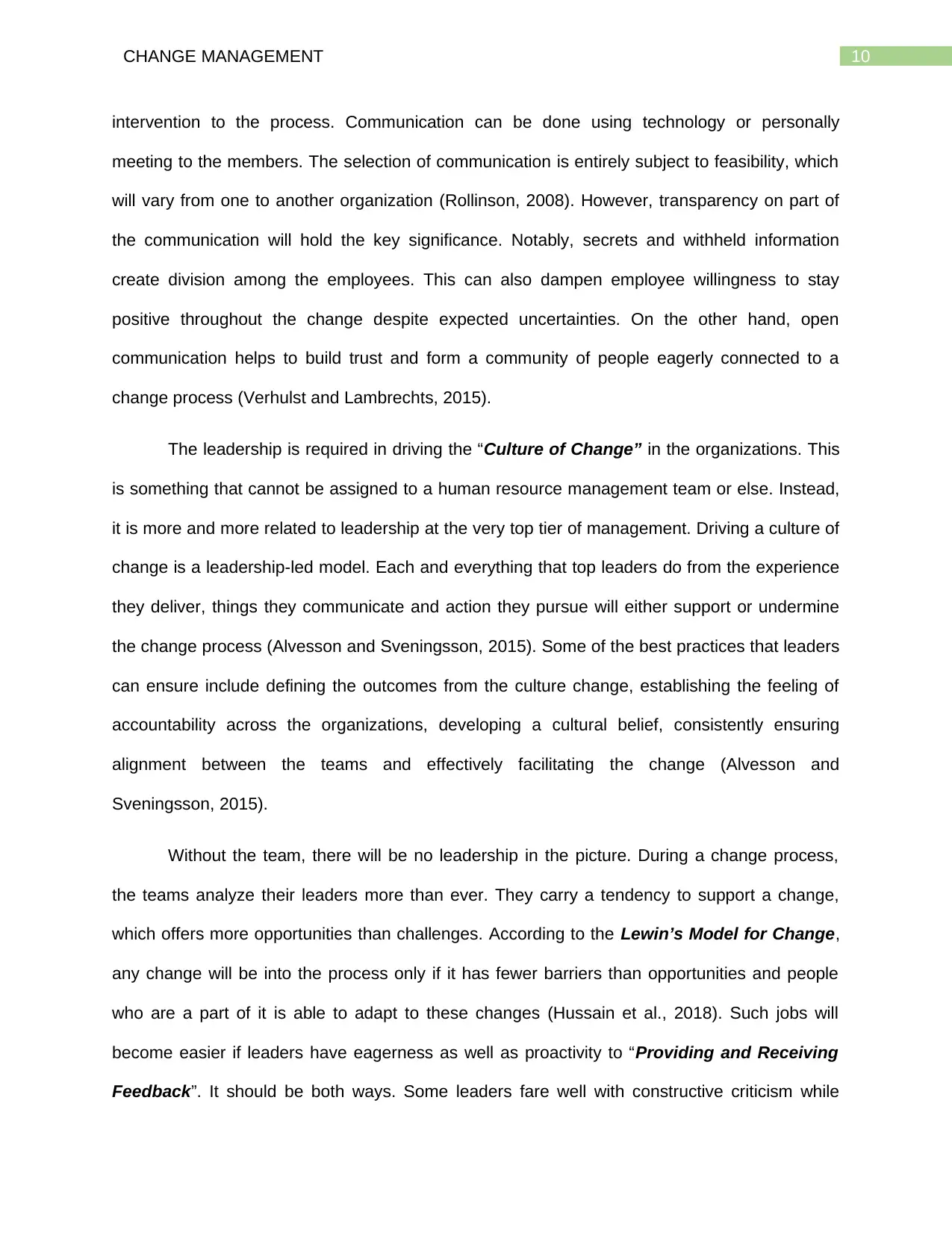
10CHANGE MANAGEMENT
intervention to the process. Communication can be done using technology or personally
meeting to the members. The selection of communication is entirely subject to feasibility, which
will vary from one to another organization (Rollinson, 2008). However, transparency on part of
the communication will hold the key significance. Notably, secrets and withheld information
create division among the employees. This can also dampen employee willingness to stay
positive throughout the change despite expected uncertainties. On the other hand, open
communication helps to build trust and form a community of people eagerly connected to a
change process (Verhulst and Lambrechts, 2015).
The leadership is required in driving the “Culture of Change” in the organizations. This
is something that cannot be assigned to a human resource management team or else. Instead,
it is more and more related to leadership at the very top tier of management. Driving a culture of
change is a leadership-led model. Each and everything that top leaders do from the experience
they deliver, things they communicate and action they pursue will either support or undermine
the change process (Alvesson and Sveningsson, 2015). Some of the best practices that leaders
can ensure include defining the outcomes from the culture change, establishing the feeling of
accountability across the organizations, developing a cultural belief, consistently ensuring
alignment between the teams and effectively facilitating the change (Alvesson and
Sveningsson, 2015).
Without the team, there will be no leadership in the picture. During a change process,
the teams analyze their leaders more than ever. They carry a tendency to support a change,
which offers more opportunities than challenges. According to the Lewin’s Model for Change,
any change will be into the process only if it has fewer barriers than opportunities and people
who are a part of it is able to adapt to these changes (Hussain et al., 2018). Such jobs will
become easier if leaders have eagerness as well as proactivity to “Providing and Receiving
Feedback”. It should be both ways. Some leaders fare well with constructive criticism while
intervention to the process. Communication can be done using technology or personally
meeting to the members. The selection of communication is entirely subject to feasibility, which
will vary from one to another organization (Rollinson, 2008). However, transparency on part of
the communication will hold the key significance. Notably, secrets and withheld information
create division among the employees. This can also dampen employee willingness to stay
positive throughout the change despite expected uncertainties. On the other hand, open
communication helps to build trust and form a community of people eagerly connected to a
change process (Verhulst and Lambrechts, 2015).
The leadership is required in driving the “Culture of Change” in the organizations. This
is something that cannot be assigned to a human resource management team or else. Instead,
it is more and more related to leadership at the very top tier of management. Driving a culture of
change is a leadership-led model. Each and everything that top leaders do from the experience
they deliver, things they communicate and action they pursue will either support or undermine
the change process (Alvesson and Sveningsson, 2015). Some of the best practices that leaders
can ensure include defining the outcomes from the culture change, establishing the feeling of
accountability across the organizations, developing a cultural belief, consistently ensuring
alignment between the teams and effectively facilitating the change (Alvesson and
Sveningsson, 2015).
Without the team, there will be no leadership in the picture. During a change process,
the teams analyze their leaders more than ever. They carry a tendency to support a change,
which offers more opportunities than challenges. According to the Lewin’s Model for Change,
any change will be into the process only if it has fewer barriers than opportunities and people
who are a part of it is able to adapt to these changes (Hussain et al., 2018). Such jobs will
become easier if leaders have eagerness as well as proactivity to “Providing and Receiving
Feedback”. It should be both ways. Some leaders fare well with constructive criticism while
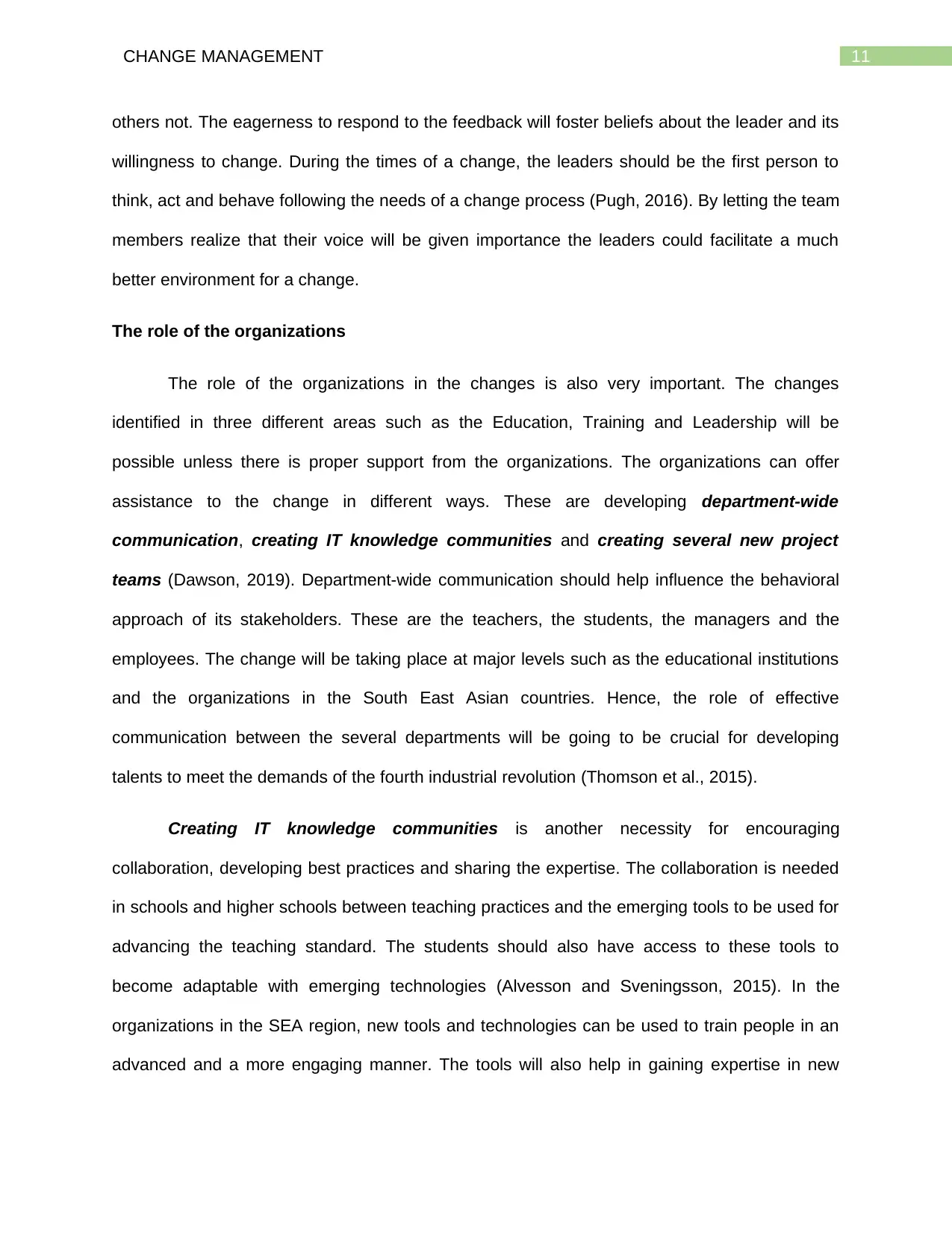
11CHANGE MANAGEMENT
others not. The eagerness to respond to the feedback will foster beliefs about the leader and its
willingness to change. During the times of a change, the leaders should be the first person to
think, act and behave following the needs of a change process (Pugh, 2016). By letting the team
members realize that their voice will be given importance the leaders could facilitate a much
better environment for a change.
The role of the organizations
The role of the organizations in the changes is also very important. The changes
identified in three different areas such as the Education, Training and Leadership will be
possible unless there is proper support from the organizations. The organizations can offer
assistance to the change in different ways. These are developing department-wide
communication, creating IT knowledge communities and creating several new project
teams (Dawson, 2019). Department-wide communication should help influence the behavioral
approach of its stakeholders. These are the teachers, the students, the managers and the
employees. The change will be taking place at major levels such as the educational institutions
and the organizations in the South East Asian countries. Hence, the role of effective
communication between the several departments will be going to be crucial for developing
talents to meet the demands of the fourth industrial revolution (Thomson et al., 2015).
Creating IT knowledge communities is another necessity for encouraging
collaboration, developing best practices and sharing the expertise. The collaboration is needed
in schools and higher schools between teaching practices and the emerging tools to be used for
advancing the teaching standard. The students should also have access to these tools to
become adaptable with emerging technologies (Alvesson and Sveningsson, 2015). In the
organizations in the SEA region, new tools and technologies can be used to train people in an
advanced and a more engaging manner. The tools will also help in gaining expertise in new
others not. The eagerness to respond to the feedback will foster beliefs about the leader and its
willingness to change. During the times of a change, the leaders should be the first person to
think, act and behave following the needs of a change process (Pugh, 2016). By letting the team
members realize that their voice will be given importance the leaders could facilitate a much
better environment for a change.
The role of the organizations
The role of the organizations in the changes is also very important. The changes
identified in three different areas such as the Education, Training and Leadership will be
possible unless there is proper support from the organizations. The organizations can offer
assistance to the change in different ways. These are developing department-wide
communication, creating IT knowledge communities and creating several new project
teams (Dawson, 2019). Department-wide communication should help influence the behavioral
approach of its stakeholders. These are the teachers, the students, the managers and the
employees. The change will be taking place at major levels such as the educational institutions
and the organizations in the South East Asian countries. Hence, the role of effective
communication between the several departments will be going to be crucial for developing
talents to meet the demands of the fourth industrial revolution (Thomson et al., 2015).
Creating IT knowledge communities is another necessity for encouraging
collaboration, developing best practices and sharing the expertise. The collaboration is needed
in schools and higher schools between teaching practices and the emerging tools to be used for
advancing the teaching standard. The students should also have access to these tools to
become adaptable with emerging technologies (Alvesson and Sveningsson, 2015). In the
organizations in the SEA region, new tools and technologies can be used to train people in an
advanced and a more engaging manner. The tools will also help in gaining expertise in new
⊘ This is a preview!⊘
Do you want full access?
Subscribe today to unlock all pages.

Trusted by 1+ million students worldwide
1 out of 17
Related Documents
Your All-in-One AI-Powered Toolkit for Academic Success.
+13062052269
info@desklib.com
Available 24*7 on WhatsApp / Email
![[object Object]](/_next/static/media/star-bottom.7253800d.svg)
Unlock your academic potential
Copyright © 2020–2025 A2Z Services. All Rights Reserved. Developed and managed by ZUCOL.





